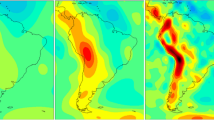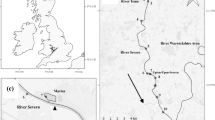Abstract
Light-based archival tags are increasingly being used on free-ranging marine vertebrates to study their movements using geolocation estimates. These methods use algorithms that incorporate threshold light techniques to determine longitude and latitude. More recently, researchers have begun using sea surface temperature (SST) to determine latitude in temperate regions. The accuracy and application of these algorithms have not been validated on free-ranging birds. Errors in both geolocation methods were quantified by double-tagging Laysan (Phoebastria immutabilis Rothschild) and black-footed (P. nigripes Audubon) albatrosses with both leg-mounted archival tags that measured SST and ambient light, and satellite transmitters. Laysan albatrosses were captured and released from breeding colonies on Tern Island, northwestern Hawaiian Islands (23°52′N, 166°17′W) and Guadalupe Island, Mexico (28°31′N, 118°10′W) and black-footed albatrosses from Tern Island. Studies were carried out between December 2002 and March 2003. For all birds combined, the mean ± SD great circle (GC) distance between light-based locations and satellite-derived locations was 400±298 km (n=131). Errors in geolocation positions were reduced to 202±171 km (n=154) when light-based longitude and SST-based latitude (i.e. SST/light) were used to establish locations. The SST/light method produced comparable results for two Laysan albatross populations that traveled within distinctly different oceanic regions (open ocean vs more coastal) whereas light-based methods produced greater errors in the coastal population. Archival tags deployed on black-footed albatrosses returned a significantly higher proportion of lower-quality locations, which was attributed to interference of the light sensor on the tag. Overall, the results demonstrate that combining measures of light-based longitude and SST-based latitude significantly reduces the error in location estimates for albatrosses and can provide valid latitude estimates during the equinoxes, when light-based latitude measurements are indeterminate.



Similar content being viewed by others
References
Alerstam T, Gudmundsson GA, Larsson B (1993) Flight tracks and speed of Antarctic and Atlantic seabirds: radar and optical measurements. Philos Trans R Soc Lond B 340:55–67
Anderson DJ, Ricklefs RE (1987) Radio-tracking masked and blue-footed boobies (Sula spp.) in the Galapagos Islands. Nat Geogr Res 3:152–163
Beck CA, McMillan JI, Bowen WD (2002) An algorithm to improve geolocation positions using sea surface temperature and diving depth. Mar Mamm Sci 18:940–951
Block BA, Dewar H, Blackwell SB, Williams T, Farwell CJ, Prince ED, Boustany A, Teo SLH, Seitz A, Fudge D, Walli A (2001) Electronic tags reveal migratory movements, depth preferences and thermal biology of Atlantic bluefin tuna. Science 293:1310–1314
Boustany A, Davis S, Anderson S, Pyle P, Block BA (2002) Satellite tags reveal expanded ecological niche for white sharks in the North Pacific. Nature 415:35–36
Bradshaw CJA, Hindell MA, Michael KJ, Summer MD (2002) The optimal spatial scale for the analysis of elephant seal foraging as determined by geo-location in relation to sea surface temperatures. ICES J Mar Sci 59:770–781
Catard A, Weimerskirch H, Cherel Y (2000) Exploitation of distant Antarctic waters and close shelf-break waters by white-chinned petrels rearing chicks. Mar Ecol Prog Ser 194:249–261
Costa DP (1993) The secret life of marine mammals: novel tools for studying their behavior and biology at sea. Oceanography 6:120–128
Davis LS, Miller GD (1992) Satellite tracking of Adelie penguins. Polar Biol 12:503–506
DeLong RL, Stewart BS, Hill RD (1992) Documenting migrations of northern elephant seals using day length. Mar Mamm Sci 8:155–159
Ekstrom P (2004) An advance in geolocation by light. Mem Nat Inst Polar Res (Special Issue) 58:210–226
Fancy SG, Pank LF, Douglas DC, Curby CH, Garner GW, Amstrup SC, Regelin WL (1988) Satellite telemetry: a new tool for wildlife research and management. U.S. Dept. of the Interior, USFWS, Washington, DC
Fernández P, Anderson DJ (2000) Nocturnal and diurnal foraging activity of Hawaiian albatrosses detected with a new immersion monitor. Condor 102:577–584
Fritz H, Said S, Weimerskirch H (2003) Scale-dependent hierarchical adjustments of movement patterns in a long-range foraging seabird. Proc R Soc Lond B 270:1143–1148
Grémillet D, Wilson RP, Wanless S, Chater T (2000) Black-browed albatrosses, international fisheries and the Patagonian shelf. Mar Ecol Prog Ser 195:269–280
Grémillet D, Dell’Omo G, Ryan PG, Peters G, Ropert-Coudert Y, Weeks SJ (2004) Offshore diplomacy, or how seabirds mitigate intra-specific competition: a case study based on GPS tracking of Cape gannets from neighbouring colonies. Mar Ecol Prog Ser 268:265–279
Guinet C, Koudil M, Bost CA, Durbec JP, Georges JY, Mouchat MC, Jouventin P (1997) Foraging behaviour of satellite-tracked king penguins in relation to sea-surface temperatures obtained by satellite telemetry at Crozet Archipelago, a study during three austral summers. Mar Ecol Prog Ser 150:11–20
Gunn J, Polacheck T, Davis T, Sherlock M, Bethlehem A (1994) The development and use of archival tags for studying the migration, behaviour and physiology of southern bluefin tuna, with an assessment of the potential for transfer of the technology to groundfish research. ICES mini symposium on fish migration. ICES, Copenhagen
Hill RD (1994) Theory of geolocation by light levels. In: Le Boeuf BJ, Laws RM (eds) Elephant seals: population ecology, behavior, and physiology. University of California Press, Berkeley, pp 227–236
Hull CL (1999) The foraging zones of breeding royal (Eudyptes schlegeli) and rockhopper (E. chrysocome) penguins: an assessment of techniques and species comparison. Wildl Res 26:789–803
Hull CL (2000) Comparative diving behaviour and segregation of the marine habitat by breeding royal penguins, Eudyptes schlegeli, and eastern rockhopper penguins, Eudyptes chrysocome filholi, at Macquarie Island. Can J Zool 78:333–345
Hunt GL Jr, Melhum F, Russell RW, Irons DB, Decker MB, Becker PH (1999) Physical processes, prey abundance, and the foraging ecology of seabirds. In: Adams NJ, Slotow RH (eds) Proceedings of the 22nd International Ornithological Congress. Bird Life South Africa, Durban, pp 2040–2056
Jouventin P, Weimerskirch H (1990) Satellite tracking of wandering albatrosses. Nature 343:746–748
Le Boeuf BJ, Crocker DE, Costa DP, Blackwell SB, Webb PM, Houser DS (2000) Foraging ecology of northern elephant seals. Ecol Monogr 70:353–382
Musyl MK, Brill RW, Curran DS, Gunn JS, Hartog JR, Hill RD, Welch DW, Eveson JP, Boggs CH, Brainard RE (2001) Ability of archival tags to provide estimates of geographical position based on light intensity. In: Sibert JR, Nielsen JL (eds) Electronic tagging and tracking in marine fisheries. Kluwer, Dordrecht, pp 343–367
Pennycuick CJ (1982) The flight of petrels and albatrosses (Procellariiformes), observed in South Georgia and its vicinity. Philos Trans R Soc Lond B 300:75–106
Pennycuick CJ, Schaffner FC, Fuller MR, Obrecht HH III, Sternberg L (1990) Foraging flights of the white-tailed tropicbird (Paethon lepturus): radiotracking and doubly-labeled water. Col Waterbirds 13:96–102
Pickard GL, Emery WJ (1990) Descriptive physical oceanography: an introduction, 5th edn. Pergamon Press, Oxford
Phillips RA, Silk JRD, Croxall JP, Afanasyev V, Briggs DR (2004) Accuracy of geolocation estimates for flying seabirds. Mar Ecol Prog Ser 266:265–272
Polovina JJ, Kobyashi DR, Ellis DM, Seki MP, Balasz GH (2000) Turtles on the edge: movement of loggerhead turtles (Caretta caretta) along oceanic fronts in the central North Pacific. Fish Oceanogr 9:71–82
Prince PA, Wood AG, Barton T, Croxall JP (1992) Satellite tracking of wandering albatrosses (Diomedea exulans) in the South Atlantic. Antarct Sci 4:31–36
Pütz K (2002) Spatial and temporal variability in the foraging areas of breeding king penguins. Condor 104:528–538
Schlitzer R (2004) Ocean data view 2.0. http://www.awi-bremerhaven.de/GEO/ODV
Schneider DC (1994) Quantitative ecology: spatial and temporal scaling. Academic Press, San Diego
Shaffer SA, Costa DP, Weimerskirch H (2001) Behavioural factors affecting foraging effort of breeding wandering albatrosses. J Anim Ecol 70:864–874
Smith P, Goodman D (1986) Determining fish movements from an ‘archival’ tag: precision of geographical positions made from a time series of swimming temperature and depth. NOAA Tech Memo NMFS SWFC-60:1–13
Teo SLH, Boustany A, Blackwell SB, Walli A, Weng KC, Block BA (2004) Validation of geolocation estimates based on light level and sea surface temperature from electronic tags. Mar Ecol Prog Ser 283:81–98
Warham J (1996) The behaviour, population biology and physiology of the petrels. Academic Press, San Diego
Weimerskirch H, Guionnet T (2002) Comparative activity pattern during foraging of four albatross species. Ibis 144:40–50
Weimerskirch H, Wilson RP (2000) Oceanic respite for wandering albatrosses. Nature 406:955–956
Weimerskirch H, Doncaster CP, Cuenot-Chaillet F (1994) Pelagic seabirds and the marine environment: foraging patterns of wandering albatrosses in relation to prey availability and distribution. Proc R Soc Lond B 255:91–97
Weimerskirch H, Wilson RP, Guinet C, Koudil M (1995) Use of seabirds to monitor sea-surface temperatures and to validate satellite remote-sensing measurements in the Southern Ocean. Mar Ecol Prog Ser 126:299–303
Weimerskirch H, Wilson RP, Lys P (1997) Activity pattern of foraging in the wandering albatross: a marine predator with two modes of prey searching. Mar Ecol Prog Ser 151:245–254
Weimerskirch H, Guionnet T, Martin J, Shaffer SA, Costa DP (2000) Fast and fuel-efficient? Optimal use of wind by flying albatrosses. Proc R Soc Lond B 267:1869–1874
Weimerskirch H, Bonadonna F, Bailleul F, Mabille G, Dell’Omo G, Lipp H-P (2002) GPS tracking of foraging albatrosses. Science 295:1259
Welch DW, Eveson JP (1999) An assessment of light-based geoposition estimates from archival tags. Can J Fish Aquat Sci 56:1317–1327
Wilson RP, Ducamp JJ, Rees WG, Culik BM, Nickamp K (1992) Estimation of location: global coverage using light intensity. In: Priede IG, Swift SM (eds) Wildlife telemetry: remote monitoring and tracking of animals. Ellis Horwood, New York, pp 131–134
Wilson RP, Weimerskirch H, Lys P (1995) A device for measuring seabird activity at sea. J Avian Biol 26:172–175
Wilson RP, Grémillet D, Syder J, Kierspel MAM, Garthe S, Weimerskirch H, Schäfer-Neth C, Alejandro Scolaro J, Bost C-A, Plötz J, Nel D (2002) Remote-sensing systems and seabirds: their use, abuse and potential for measuring marine environmental variables. Mar Ecol Prog Ser 228:241–261
Acknowledgements
We thank D. Barton and K. Lindquist for assistance in the field, Dr. B. Flint and the US Fish & Wildlife Service for logistical support on Tern Island, and Groupo Ecologica Conservación de Islas and the Mexican Navy for logistical support on Guadalupe. We also thank Dr. P. Raimondi for statistical advice, P. Robinson for programming assistance, and L. Hutnick for assistance with graphics. This research was part of the Tagging of Pacific Pelagics (TOPP) program, funded in part by the National Ocean Partnership Program (N00014-02-1-1012), and the Office of Naval Research (N00014-00-1-0880 & N00014-03-1-0651). All protocols employed in this study were approved by the Institutional Animal Care and Use Committees at UCSC. This paper is dedicated to A.M. Shaffer (b 19 October 2004).
Author information
Authors and Affiliations
Corresponding author
Additional information
Communicated by J.P. Grassle, New Brunswick
Rights and permissions
About this article
Cite this article
Shaffer, S.A., Tremblay, Y., Awkerman, J.A. et al. Comparison of light- and SST-based geolocation with satellite telemetry in free-ranging albatrosses. Marine Biology 147, 833–843 (2005). https://doi.org/10.1007/s00227-005-1631-8
Received:
Accepted:
Published:
Issue Date:
DOI: https://doi.org/10.1007/s00227-005-1631-8




